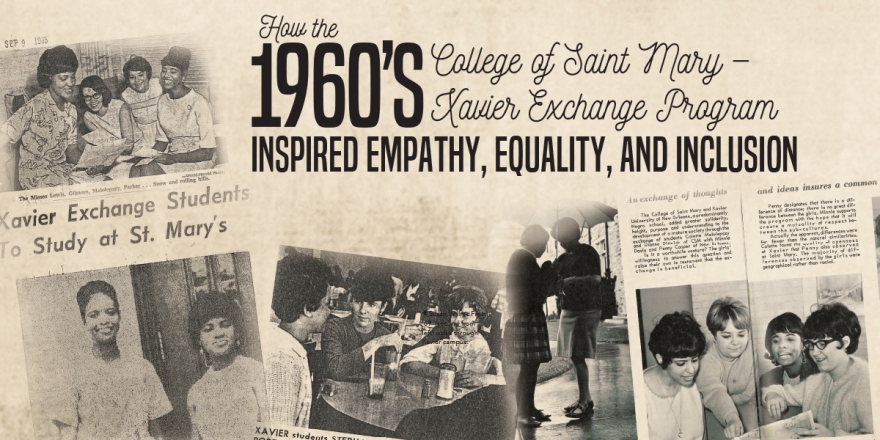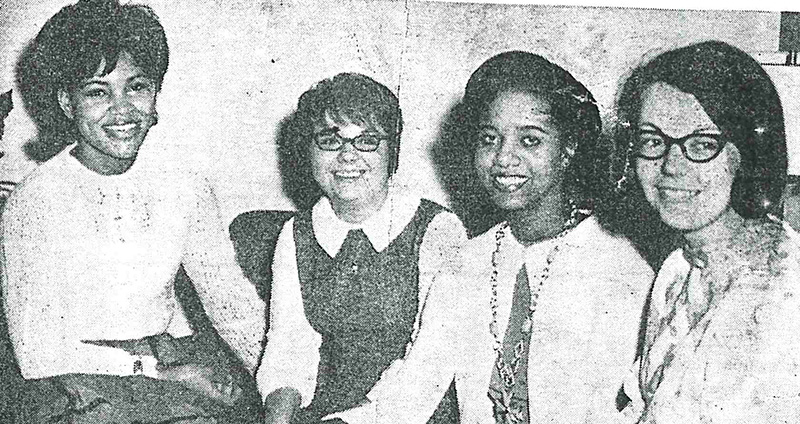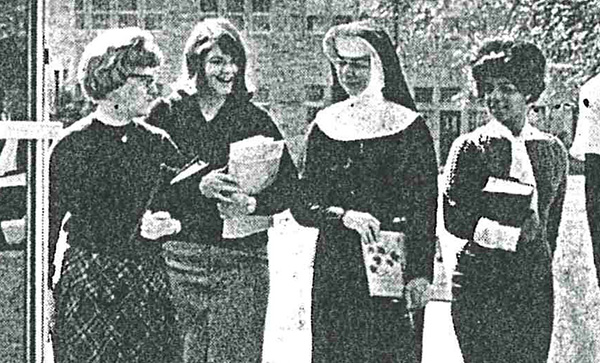
How the 1960s College of Saint Mary – Xavier Exchange Program Inspired Empathy, Equality, and Inclusion
In the fall of 1966, Frances Shani Parker stood in front of a College of Saint Mary classroom full of shocked white faces. As an African American growing up in the Jim Crow South, the world had told her she wasn’t as capable as white people. But she stood tall during a spelling bee on that fall day in Nebraska, spelling word after word correctly, as the students around her took their seats.
“It was a defining moment,” she recalls. “There was a voice in my head – every time I tell the story, I hear the voice. And it was ‘I’m as smart as white people and smarter than some.’ I shouldn’t have ever thought that I wasn’t. But that’s the damage of growing up with racism and segregation.”
This life-changing moment was part of a progressive exchange program CSM implemented in the fall of 1965 and 1966 with Xavier University of Louisiana—the only Catholic historically black college in the country. Throughout the two-year partnership, a total of eight students, four from each school, swapped colleges and spent a semester on a new campus. In an era that was fraught with racial injustices, widespread segregation, and a mounting call for equality, those eight students traveled a thousand miles across the country to study, learn, and grow within an unfamiliar setting.
For Parker, the CSM-Xavier Exchange program—and the spelling bee exercise that was part of a teaching course at CSM—helped her overcome much of the destructive social programming that society had hit her with growing up.
During her time at CSM, Parker says she was often the only black student in the class. And she says it was clear most fellow students had little experience with people of different races. She saw the program as an opportunity to shed many of those racist ideas society had piled on her and find empowerment.
“Growing up, everything was segregated. I couldn’t use the segregated public library located on the block where I lived—only white people. My mother took us to a library for colored people that was located on the other side of town. It took us two buses to get there,” Parker recalls.
She says her experience at CSM helped her rise above the negative conditioning of her past and see her true value: “I was like a ship with an anchor holding me down,” she said. “That anchor was pulled up, and I was able to sail freely.”
As dramatic of an inward effect that the program had on Parker—a black woman learning and growing among white colleagues—her experiences were also positively impacting the views of a prominently white campus population. With each interaction she had and every relationship she built, women from all backgrounds were exposed to new cultural and racial experiences themselves.

Roommates on CSM campus: Carolynn Lewis (Xavier University), Collette Malolepszy † (1997), Frances Parker (Xavier University), and former CSM student Rosanne Gilmore.
Penny Cooper McKnight, a fellow Xavier student and participant in the exchange program, saw right away that her semester at College of Saint Mary wasn’t just a chance to learn; it was a chance to fight racism. She noticed most women at CSM had limited, if any, exposure to African American culture when she arrived in 1966. She says the program was a chance to imprint a lasting positive first impression for women who looked like her.
“I have really good memories of what that program was,” recounts McKnight. “I equate it as being an ambassador of a race that people didn’t understand or know.”
McKnight was first drawn to the exchange program to broaden her own perspective and see more of the world. It was a chance to grow intellectually as she built lasting relationships in a new environment. She was also able to break through negative stereotypes and reach her classmates on a deep level. Even after her time at CSM was up, the bonds she created were so strong that several of her CSM friends would visit her at Xavier.
Meanwhile, more than 1,000 miles away, Susan Willms Frost ‘69, a CSM student on the other end of that 1965 exchange program, was experiencing a whole new world at Xavier University. She says immersing herself in an unfamiliar culture opened her eyes to inequalities and new ways of life she hadn’t considered.
“The students’ situations were different compared to mine,” Frost explains. “They worked while attending school, their parents worked multiple jobs to keep them in school, and they made what seemed to be a bigger sacrifice.”
That shift in perspectives didn’t just spark empathy within Frost. She says she took the lessons she learned throughout her time at Xavier and used them to radiate positive change in her own life.
To see the sacrifice those student’s families made reinforced the value in my own family, Susan says.

Susan Willms Frost ‘69 (second from left) walks through Xavier campus.
All three view that program of the 1960s as valuable, and they see it as a step in the right direction when it comes to overcoming racial inequities. Throughout the course of 1965 and 1966, all eight of the program’s participants were able to promote growth and understanding through inclusivity.
Parker, McKnight and Frost also used their experiences on CSM and Xavier campuses to feed lifelong, purposeful service. McKnight went on to become an educator, teaching for more than 20 years before becoming an assistant principal and retiring in 2004. Parker served as a hospice volunteer for 20 years, later writing a book about her experience entitled, Becoming Dead Right: A Hospice Volunteer in Urban Nursing Homes. Frost would ultimately go on to spend 38 years as Director of Laboratories at CGH Medical Center.
Still, as valuable as the exchange program was for the women it influenced, it now shines a light on the gap in social progress that plagues the country more than half a century later.
In 1968, just two years after the program finished, Martin Luther King Jr. was assassinated. Protest followed in more than 100 cities across the nation. Throughout the last few years, various acts of racial injustice, including the killing of George Floyd in 2020, have sparked protests across the nation that echo calls for equality that sound eerily similar to the outcries from the 60s.
Today, just like in 1965, College of Saint Mary is continuing to chip away at inequalities and embolden women from all races and backgrounds. In the wake of the recent George Floyd killing, CSM decided to launch several programs to reinforce the university’s longstanding commitment to creating an inclusive community where women can learn, grow, and stride boldly on to serve in the world with purpose.
On August 6, CSM leadership kicked off a year-long, intensive program to dig into the role of leaders in building more hospitality within the university community. In addition to recently implemented Project READI (a leadership program aimed at driving more diversity-awareness), university leadership has assembled three new inclusivity and diversity leadership bodies: an Office of Diversity & Inclusion, an Inclusion, Diversity, Equity Advancement Team, and a President’s Council on Diversity, Inclusion and Equity. All three new teams draw on leadership from members throughout the CSM community in order to promote equity, inclusivity and diversity through student experiences.
Although these programs won’t solve the problem of racial injustice in the United States outright, CSM leaders hope that they’ll help society inch its way in the right direction—just as the CSM-Xavier Exchange program did decades ago. It’s a wish that participants of that progressive program of 1965 and 1966 also hold on to today.
“I think we’ve gone through a really difficult period of time, but I hope our country can heal,” says McKnight. I feel that the program that sent me from Xavier to St. Mary’s was for people to get to know each other. If we could just get to know each other, so many barriers can be removed.”











